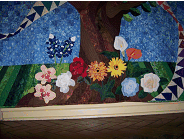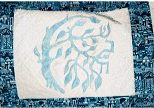
LORI WEISS Nobody does machine-embroidered quilts more exquisitely than Lori. The first image is an immaculate signature quilt she spent a year making for her son Adam's bar mitzvah. The hand-appliquéd pomegranates symbolize the 613 commandments of the Torah. The seeds were created by reverse appliqué. Each fruit took almost two hours to complete, and the quilt itself more than a year. The Hebrew lettering on bottom is L'dor v'dor, 'From Generation to Generation.'
The second image is a pieced, quilted, signed, legal ketubah, marriage contract. "The bride provided the text, in English and Aramaic....I scanned and printed it on treated fabric [See Photo page.] "I then backed the text with an interfacing so it would be stiff enough to write on. The 'tablets' were appliquéd, using a wide satin stitch. Since the text was tablet-shaped I had to come up a design to accommodate that form. I thought the tree of life/menorah design would work, so I drew it for her and she approved it. I added the two doves to symbolize the bride and groom. The embroidered chai was from 'Stitches by Sue'. The biggest challenge was appliquéing all those leaves!!! There were hundreds of them!"
The ketubah was signed by all the parties at the wedding. " I provided a pigma pen and practice fabric." The owners framed it between two pieces of glass.
Lori's article about another wonderful machine-embroidered quilt, signed by guests at her son's bar mitzvah, appeared in the Spring, 2003 issue of American Quilter Magazine. Lori lives in Coral Springs, Florida, can be reached at lfweiss(at)MYACC.NET.
The second image is a pieced, quilted, signed, legal ketubah, marriage contract. "The bride provided the text, in English and Aramaic....I scanned and printed it on treated fabric [See Photo page.] "I then backed the text with an interfacing so it would be stiff enough to write on. The 'tablets' were appliquéd, using a wide satin stitch. Since the text was tablet-shaped I had to come up a design to accommodate that form. I thought the tree of life/menorah design would work, so I drew it for her and she approved it. I added the two doves to symbolize the bride and groom. The embroidered chai was from 'Stitches by Sue'. The biggest challenge was appliquéing all those leaves!!! There were hundreds of them!"
The ketubah was signed by all the parties at the wedding. " I provided a pigma pen and practice fabric." The owners framed it between two pieces of glass.
Lori's article about another wonderful machine-embroidered quilt, signed by guests at her son's bar mitzvah, appeared in the Spring, 2003 issue of American Quilter Magazine. Lori lives in Coral Springs, Florida, can be reached at lfweiss(at)MYACC.NET.
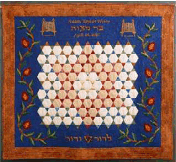
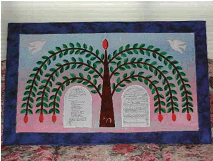
SHARON BOLTON The Phoenix, Arizona quiltmaker brings boundless energy, enthusiasm, and kavannah to her Judaic quilts. Check out the gorgeous machine-embroidered grapes on her pyramid quilt, '40 Years they Wandered,' made for the New Shul in Scottsdale, Arizona. And I'm wild about her fruity Sukkoth mat. They're at http://www.dotphoto.com/GuestViewAlbum.asp?AID=1438248&Page=1. Contact Sharon at zoomama(at)swlink.net.

LEAH ALLMAN of Peabody, Mass., made the extraordinary "Masada Mosaic" on the left in 1999. The 54" x 54" wall hanging is based on a tile floor found in the ruins of King Herod's palace at Masada "The design was drawn into the computer. Each section was numbered and printed as a full-size template. Traditional and reverse appliqué were done by hand. There is also machine piecing and extensive machine quilting, to simulate the composition of the tiles," says Leah. The quilt won a prize at the 1999 American Quilters Society Show in Paducah, Kentucky.
The second quilt, "They were Slaves in Egypt", measuring 53" x 57", was also made with a nontraditional approach. She hand-painted one piece of fabric in sky colors, another in desert colors, and sewed them together. These became the background. Triangular faces for each pyramid were freehand cut from contrasting batik fabrics. She butted the raw triangle edges together, and glued fabric strips to the back for stability, using Roxanne's applique glue, to create each pyramid. More rectangles were cut, butted, reinforced, and glued to create the slabs hauled along the ground. She cut people, statues, jars, the Pharoah's face, etc., from Egyptian-themed commercial fabrics. All these raw-edged items were glued the background. Batting and backing were added. Finally, she "machine fantasy quilted" everything--- appliqué, embroidery and machine quilting simultaneously through all the layers! Dark brown thread, straight stitched over and over, created dimensional bricks within each pyramid face. Couched twine represents the heavy ropes of bondage. For more information on this fascinating quilt, write to Leahquilter(at)comcast.net.
The second quilt, "They were Slaves in Egypt", measuring 53" x 57", was also made with a nontraditional approach. She hand-painted one piece of fabric in sky colors, another in desert colors, and sewed them together. These became the background. Triangular faces for each pyramid were freehand cut from contrasting batik fabrics. She butted the raw triangle edges together, and glued fabric strips to the back for stability, using Roxanne's applique glue, to create each pyramid. More rectangles were cut, butted, reinforced, and glued to create the slabs hauled along the ground. She cut people, statues, jars, the Pharoah's face, etc., from Egyptian-themed commercial fabrics. All these raw-edged items were glued the background. Batting and backing were added. Finally, she "machine fantasy quilted" everything--- appliqué, embroidery and machine quilting simultaneously through all the layers! Dark brown thread, straight stitched over and over, created dimensional bricks within each pyramid face. Couched twine represents the heavy ropes of bondage. For more information on this fascinating quilt, write to Leahquilter(at)comcast.net.
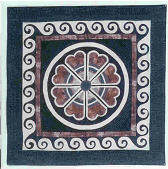
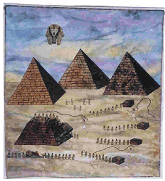

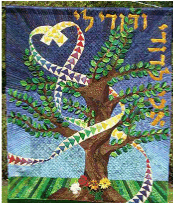
FRAN GOLDBERG created this 6' x 7' family huppa in 2003. It was inspired by a Baal Shem Tov quote: "From every human being there rises a light that reaches straight to heaven. And when two souls that were destined for each other find one another, their streams of light flow together, and a single, brighter light goes forth from their united being." The light is symbolized by the two ribbons, which form a heart shape. The inscription reads 'Ani l'dodi, v'l'dodi li - 'I am my beloved, my beloved is mine.'
The background is composed of 25 blue fabrics, gradated from dark to light, and set in 9-patches for a watercolor effect. "The 200+ tree leaves were constructed wrong side out, turned, and closed by hand," Fran explains. "I used about 30 different greens. All were done freestyle so they are slightly different sizes and shapes." They were attached down the middle, by machine, to create veins, after the rest of the quilt was finished.
Dimensional flowers are at the bottom of the tree. There's one pair for each couple who marries under the chuppah. (The second photo shows the chuppah several years after it was constructed, with more flowers added.) Stems are bias strips, and leaves are dimensional. "I put green fabrics together, wrong sides together, then satin-stitch around the edges." Each couple chose their flowers, which were added before the ceremony. "One day," Fran adds, "the whole bottom of the quilt will be a beautiful flower garden." Fran also put a large label on the back, where she writes each couple's names, wedding date and location, and which flowers are theirs.
To suspend the huppa, she had a knockdown-frame custom built. "I attach the huppa to the frame with ribbons and safety pins (real fancy!) at the four corners and several locations along the edge." Fran lives - and teaches - in Skokie, Illinois. Contact her at FGQuilter(at)rcn.com
The background is composed of 25 blue fabrics, gradated from dark to light, and set in 9-patches for a watercolor effect. "The 200+ tree leaves were constructed wrong side out, turned, and closed by hand," Fran explains. "I used about 30 different greens. All were done freestyle so they are slightly different sizes and shapes." They were attached down the middle, by machine, to create veins, after the rest of the quilt was finished.
Dimensional flowers are at the bottom of the tree. There's one pair for each couple who marries under the chuppah. (The second photo shows the chuppah several years after it was constructed, with more flowers added.) Stems are bias strips, and leaves are dimensional. "I put green fabrics together, wrong sides together, then satin-stitch around the edges." Each couple chose their flowers, which were added before the ceremony. "One day," Fran adds, "the whole bottom of the quilt will be a beautiful flower garden." Fran also put a large label on the back, where she writes each couple's names, wedding date and location, and which flowers are theirs.
To suspend the huppa, she had a knockdown-frame custom built. "I attach the huppa to the frame with ribbons and safety pins (real fancy!) at the four corners and several locations along the edge." Fran lives - and teaches - in Skokie, Illinois. Contact her at FGQuilter(at)rcn.com

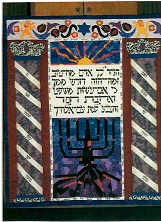

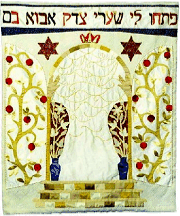
LAUREN MILLER These two extraordinary parochet (ark curtains), and the Torah covers are the work of Texas artist Lauren Miller. She created them as her bat mitzvah project (at age 44) for Congregation Kol Ami in Flower Mound, TX. The white set is for High Holy Days. "It has a portal design, like those from the 17th century. The inscription translates, 'Open for me the gates of righteousness, so that I may enter,' (from Psalms 118). The gates are opened to accept individual prayers. The columns that frame the arch are transformed into two long arms, with hands of priestly blessing." Other traditional symbols include the crown, the Magen Davids, and, in the swirling central clouds, a Shofar. This set is made from silks.
The other curtain made from cotton, also uses traditional architectural elements. The crown-topped columns bear the names of the twelve tribes. The center quote, from Micah, translates: 'He has told you, O man, what is good, and what the Lord requires of you: Only to do justice and to love goodness, and to walk modestly with your God.' The seven-branched menorah has roots at the bottom, like a Tree of Life. The words lining the center panel are the names of the 54 parshot of the Torah. All the lettering was done with fabric markers. "The colors," Lauren notes, "were chosen largely to complement the colors of our synagogue. Interestingly enough, scarlet, purple, and blue, used with linen, is an even older combination of colors than the blue and white combination that we think of as Jewish colors, and this reference goes back to the desert tabernacle (Exodus 25:8)." The curtain is hand-quilted.
The third image shows Torah covers that Lauren recently completed. She holds degrees in textile design, and has a broad range of fascinating artistic experience, including professional rug design, painted furniture, painted dreidels (She was the artist behind 'Bloomies Dreidels'), ceramics featuring Hebrew calligraphy, and ketubot. Contact her at lauren0711(at)comcast.net.
The other curtain made from cotton, also uses traditional architectural elements. The crown-topped columns bear the names of the twelve tribes. The center quote, from Micah, translates: 'He has told you, O man, what is good, and what the Lord requires of you: Only to do justice and to love goodness, and to walk modestly with your God.' The seven-branched menorah has roots at the bottom, like a Tree of Life. The words lining the center panel are the names of the 54 parshot of the Torah. All the lettering was done with fabric markers. "The colors," Lauren notes, "were chosen largely to complement the colors of our synagogue. Interestingly enough, scarlet, purple, and blue, used with linen, is an even older combination of colors than the blue and white combination that we think of as Jewish colors, and this reference goes back to the desert tabernacle (Exodus 25:8)." The curtain is hand-quilted.
The third image shows Torah covers that Lauren recently completed. She holds degrees in textile design, and has a broad range of fascinating artistic experience, including professional rug design, painted furniture, painted dreidels (She was the artist behind 'Bloomies Dreidels'), ceramics featuring Hebrew calligraphy, and ketubot. Contact her at lauren0711(at)comcast.net.

MARILYN SAXE from West Orange, N.J., saw a matzoh cover posted on my Passover page and wanted to make one as a present for a friend. She asked me if I had a pattern. I don't--but I gave her encouragement and permission to try her own, and told her my favorite places to shop for novelty fabrics.
She wasn't a quilter, but she is now! Marilyn added her own touches. "Everything was hand-appliqued onto the purple background using the ladder stitch." She couldn't locate matzo fabric, so she made her own with gorgeous hand-stitching on a splotchy mocha-colored fabric. The plague names were written out in Hebrew by her friend's five grandchildren. And the grandchildren signed a label on the back.
"I'm not sure how 'kosher' it all was, quilting-wise, but I was happy with the results." Marilyn says. "Coming from me, who's usually quite a 'perfectionist' that's great! And, I do think that a lot of that comes from the good feeling I had in making it and thinking of my dear friends-- and from the kind help you gave me. The kids are quite proud of it, and especially that it was made by me, who's 'not even Jewish!' " Marilyn's email is msaxe_2000(at)yahoo.com
She wasn't a quilter, but she is now! Marilyn added her own touches. "Everything was hand-appliqued onto the purple background using the ladder stitch." She couldn't locate matzo fabric, so she made her own with gorgeous hand-stitching on a splotchy mocha-colored fabric. The plague names were written out in Hebrew by her friend's five grandchildren. And the grandchildren signed a label on the back.
"I'm not sure how 'kosher' it all was, quilting-wise, but I was happy with the results." Marilyn says. "Coming from me, who's usually quite a 'perfectionist' that's great! And, I do think that a lot of that comes from the good feeling I had in making it and thinking of my dear friends-- and from the kind help you gave me. The kids are quite proud of it, and especially that it was made by me, who's 'not even Jewish!' " Marilyn's email is msaxe_2000(at)yahoo.com
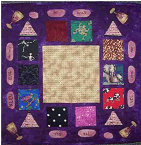


MYRA POSNER is a multitalented Southern California artist. One of her first quilting projects was the memory quilt on the left.She machine-embroidered the inscription, which reads, 'L'dor v'dor, nagid gadlecha' - "From generation to generation, we tell of Your greatness." She used family photos, of everything from ancestors from Poland and Russia, up to her grandchild's bris in 2002. (There's even a scan of a 50-year-old watercolor painting of her father's Boston kosher meat market! ) The finished wall hanging measures 29" square.
On the right is a portrait Myra made from a photograph of her friend Lou, a Survivor. The portrait came as a surprise to Lou, "And he was very pleased when I finally presented it to him!" She made it as a project for the Quilt University class taught by Marilyn Belford, called 'Realistic Fabric Portraits.' "It was enjoyable, though difficult the first time around," Myra say. "I really should do another one!" Reach her at myra(at)posner .net.
On the right is a portrait Myra made from a photograph of her friend Lou, a Survivor. The portrait came as a surprise to Lou, "And he was very pleased when I finally presented it to him!" She made it as a project for the Quilt University class taught by Marilyn Belford, called 'Realistic Fabric Portraits.' "It was enjoyable, though difficult the first time around," Myra say. "I really should do another one!" Reach her at myra(at)posner .net.
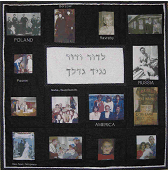
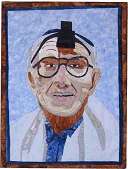

ROZ AGULNICK of Montreal Canada, made this wall hanging as a wedding present, from a pattern by Oy Vey Quilt Designs. (See Resources, under 'More Quilting Groups.'). Carolyn Nassi did blanket stitching around all the fused figures, and Roz hand-quilted it. Roz is one of the founders of of Montreal, Canada's only Jewish quilt guild, "Kvilt and Kvetch.!' You can find a nice article and picture at http://www.cjnews.com/viewarticle.asp?id=6819. Roz is at roz2(at)videotron.ca

PAMELA QUEBBEMAN of Brookfield, Wisconsin, made a neat wedding quilt/signature quilt/party quilt/chuppah for her daughter's wedding in 2002. She adapted a design by Mary Lou Weideman to create a portrait of the actual wedding (and the cake!) Read about it on my other site, at http://www.partyquilt.com/Gallery.htm. (Scroll down to 'Portrait of a Bride, a Groom, and a Cake.')

TERESA SMITH hails from Texas. She wrote me a letter a while back, telling me that she is not Jewish, but wanted to make a special gift for a Jewish friend, Barbara. She wanted to feature a block that had some kind of Jewish meaning, and had heard of a "Children of Israel" block. I helped her track it down. My reward a couple of months later, was this beautiful picture of Barbara and her quilt. Teresa explained the colors: "The pale yellow represents sunshine, green is for the promised land, blue is for the sky and water, and of course, the famous star," (where the sashing comes together). "I had so much fun working on the quilt. Thank you for your help. Barbara said she loves it, her daughter and son were delighted as well." Teresa's email is smith_tk79(at)yahoo.com.
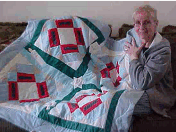

SHIRA MILLER is an Israeli quilter who was bitten by the chuppah-making bug about 6 years ago, when two of her daughers were married in the same week! She made two chuppot in time for the ceremonies! Since then, she's been making several every year. She donated two of them to Hadassah, and accepts commissions from the U.S. and Israel. Contact her at golangrl(at)afik.org.
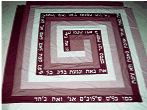

SUSAN KOHNSTAM For this ark curtain, Susan, who hails from the Gulf Coast of Florida, started with picture of a Jerusalem scene. "I took it to a drafting store, had it blown up to size, and traced it onto a large piece of fabric. I made paper templates and traced them on to a paper-backed fusible. I used upholstery fabric (from books a local decorator shop had given away) for the houses. I ironed them on to the large fabric and sewed them down using decorative stitches. I found myself changing the houses' shapes and fabric as I went along." It was finished like a regular quilt, with batting and backing, and measures 47" x 77"
The second image shows the huppa Susan made for her son's 2004 wedding , Susan used hand tracings, including her own, and others gathered by her son and his fiancé. They were applied with fusible. The green background is made from curved green blocks. To do this, Susan explains, "I cut five 40" squares of various green batiks, ironed them onto Wonder Under (TM), stacked them up and cut them horizontally and vertically in curved lines. Then I shuffled them so that no 2 like pieces of fabric were next to each other. After top-stitching with an embroidery stitch came the toughest and messiest part: peeling off all that paper! I probably won't try this again! It did however, make it easy to adhere it to the batting and it does lie nice and flat."
Around the edges, Susan embroidered, 'I am my beloved, and my beloved is mine,' 'Surrounded by loving hands,' and "various other words of wisdom!" Contact Susan at skohnstam(at)COMCAST.NET
The second image shows the huppa Susan made for her son's 2004 wedding , Susan used hand tracings, including her own, and others gathered by her son and his fiancé. They were applied with fusible. The green background is made from curved green blocks. To do this, Susan explains, "I cut five 40" squares of various green batiks, ironed them onto Wonder Under (TM), stacked them up and cut them horizontally and vertically in curved lines. Then I shuffled them so that no 2 like pieces of fabric were next to each other. After top-stitching with an embroidery stitch came the toughest and messiest part: peeling off all that paper! I probably won't try this again! It did however, make it easy to adhere it to the batting and it does lie nice and flat."
Around the edges, Susan embroidered, 'I am my beloved, and my beloved is mine,' 'Surrounded by loving hands,' and "various other words of wisdom!" Contact Susan at skohnstam(at)COMCAST.NET
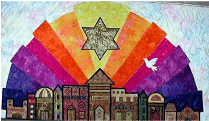
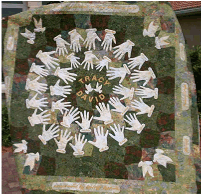

SHARON GATES Some historians believe that Christopher Columbus was Jewish. (Others contend that his cartographer was a Member of the Tribe). Both would surely have appreciated this 20" x 20" mariner's compass block made by Sharon Gates. She started it at a retreat with teachers Anita Shackelford and Sharon Stroud. It's hand-pieced and hand-quilted. The appliquéd letters read "Shalom." "It's a wallhanging, but I may use it for yontif on the table as a mat for candles." Nice, Sharon! Sharon lives in Cote St. Luc, a suburb of Montreal, and is one of the cofounders of Kvilt'n'Kvetch, Montreal's first and only Jewish quilting guild.


GRACE LIPPMAN Here's a classic American folk-sampler style quilt that served as a beautiful chuppah for a California wedding. Grace, a New Yorker, made each block symbolize an aspect of the bride's childhood . Email: Grace.Lippman(at)sharpsec.com
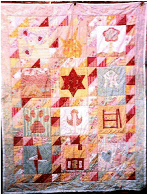

MARY ANN ROSENBLOOM This lovely 'Tree of Life' challah cover was made by Winnipeg, Canada quilter Mary Ann Rosenbloom. The appliqué is her original design---branches spell 'Shabbat'. She surrounded the center with a blue Jerusalem print fabric. Mary Ann and a group of friends recently started a Jewish quilting group. Reach Mary Ann at m2rosenbloom(at)shaw.ca. (And see Mary Ann's lyrical portrayal of Puah and Shiphrah, in the 'Group Hug' quilt below!).

SUZY LENKOWSKY's on a roll! She was going to make ONE tallit for her son David's bar mitzvah. That multiplied! The first one, which I call 'The Water Tallit', uses a wavy blue and purple print. The second one, incorporating a music print, is now worn proudly by our cantor. The third uses 'Western Wall' fabric (now, alas, out of print), for the stripes and the corners. (Hebrew letters were stenciled). For all three, the main fabric is a light silk noile that Suzy bought for about $3.50 a yard (such a deal!) at Silkconnection.com (no affiliation). She left them their natural color, but she didn't have to: "These silks take dye nicely....I tried it on a sample."





A cybergroup of Israeli, American, U.S., Canadian, and Australian quilters made these blocks. We used one Jerusalem-themed fabric, as a unifying theme. Marge Bresel of Omaha Nebraska arranged and finished the quilt, with a lot of help from friends. The quilt now hangs at Kol Rina, the Nachlaot community shul in Israel. It was donated to this synagogue as a way of thanking them for hosting the mitzvah quilting group called 'Quilted Hugs'.You can buy a beautiful oversized 5" x 7" postcard of this quilt (to help defray Marge's costs) by emailing her directly, at breselms@cox.net (No financial affiliation!).
Participants and blocks included (Top row, from right to left): Elana Schachter, Israel, 'Nitzevet bat Ada'el (mother of David) cuddles her son and sings lullabies, giving him his love for music and poetry'; Shulamit Ron, Israel, 'Shulamit (Rose of Sharon), based on the Song of Songs and the description of the beloved women as a Rose of Sharon'; Sharon Bolton (Arizona) 'Eve: A Reach, not a Fall: First woman, first wife, first mother, first to reach to be more; Cathy Perlmutter, California 'Women of the Exodus: They made the matzoh and ran!'; Sharon Landecker, California, 'Tamar, a daring and courageous Canaanite women who risked death by fire to have a child; a direct ancestor of David'; Koren Kassirer, Canada, 'Daughters of Tzelophechad: When their father died without sons, these women brought the issue of women's inheritance to Moses,';Allye Kranish, Maryland, 'Song of Deborah.'
Center Row, right to left: Laurie Nathan, New York, 'All the Unnamed Women; They carried our traditions through the ages.; Mary Ann Rosenbloom, Canada, 'Shifra and Puah : Defying Pharoah, these midwives saved the infant Moses; they stand in water representing birth and the Nile." ; Susan Pel-Or, Israel, 'Shabbat Bride: Under the bridal canopy, the Shabbat Kallah looks over Jerusalem, carrying candles and wearing pearls; Annabell Samuel, Australia, 'Zipora at the Well: Moses protected Zipora as her sheep drank at the well. Zipora's father gave her to Moses." , Marilyn Levy, Canada, 'Pomegranate; The beautiful pomegranate is beaded with approximately 613 French knots and beads, to represent the 613 mitzvot; ; Miriam K. Sokoloff, Massachusetts, 'Miriam the Prophetess: Miriam, sister of Moses, led the women in song after crossing the Sea of Reeds during the Exodus.
Bottom row, right to left: Allye Kranish, Maryland, 'Song of Deborah' "Deborah gave counsel under the palm trees. The brown stave was used by Yael to defeat Cissera." ; Debbie Sichel, California, 'Yochaved's Star: Yochabed was the mother of Aaron, high priest, Miriam, phophetess, and Moses, prophet. She was a mother's mother! ; Jacki Eisenberg, Virginia, 'Women at the well: For all the named and unnamed women in the Bible who went to the well" , Debbie Markowitz, Israel, 'Queen Esther. shown hidden to symbolize her modesty and her ability to keep a secret; Belle Plummer, Illinois, 'Deborah.'
The Nebraskans who helped finish the quilt included Doris Alloy, Enid Blumenthal, Esther Bogdanoff, Midge Bowers, Annette Fettman, Sandee Friedman, Cathy Gluck, Yael Gluck, Shirley Goodman, and Sandy Passer. Quilting designs are from The Seven Species by Shulamit Ron. Thanks to all!
Center Row, right to left: Laurie Nathan, New York, 'All the Unnamed Women; They carried our traditions through the ages.; Mary Ann Rosenbloom, Canada, 'Shifra and Puah : Defying Pharoah, these midwives saved the infant Moses; they stand in water representing birth and the Nile." ; Susan Pel-Or, Israel, 'Shabbat Bride: Under the bridal canopy, the Shabbat Kallah looks over Jerusalem, carrying candles and wearing pearls; Annabell Samuel, Australia, 'Zipora at the Well: Moses protected Zipora as her sheep drank at the well. Zipora's father gave her to Moses." , Marilyn Levy, Canada, 'Pomegranate; The beautiful pomegranate is beaded with approximately 613 French knots and beads, to represent the 613 mitzvot; ; Miriam K. Sokoloff, Massachusetts, 'Miriam the Prophetess: Miriam, sister of Moses, led the women in song after crossing the Sea of Reeds during the Exodus.
Bottom row, right to left: Allye Kranish, Maryland, 'Song of Deborah' "Deborah gave counsel under the palm trees. The brown stave was used by Yael to defeat Cissera." ; Debbie Sichel, California, 'Yochaved's Star: Yochabed was the mother of Aaron, high priest, Miriam, phophetess, and Moses, prophet. She was a mother's mother! ; Jacki Eisenberg, Virginia, 'Women at the well: For all the named and unnamed women in the Bible who went to the well" , Debbie Markowitz, Israel, 'Queen Esther. shown hidden to symbolize her modesty and her ability to keep a secret; Belle Plummer, Illinois, 'Deborah.'
The Nebraskans who helped finish the quilt included Doris Alloy, Enid Blumenthal, Esther Bogdanoff, Midge Bowers, Annette Fettman, Sandee Friedman, Cathy Gluck, Yael Gluck, Shirley Goodman, and Sandy Passer. Quilting designs are from The Seven Species by Shulamit Ron. Thanks to all!
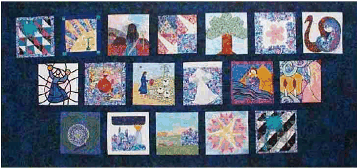
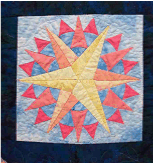
'Yochaved's Star' block, by Deborah Sichel, z''h an extraordinary quilter. You are missed.

MARCI HUGGINS
Dear Rabbi: Should my wedding canopy match my tattoo?*
I have heard a lot of great huppa stories, but this is in a category of its own.
It all started rather traditionally. Quilter Marcy Huggins of Minneapolis a quilter for 20 years, who happens to be tattoo-free, decided to make her first appliqué quilt. It was to be a huppa for a beloved young woman, the daughter of a good friend, who is also, incidentally, untattooed. Marcy had been close to the bride ever since the young woman was a baby.
Marcy envisioned a Tree of Life design. "I wanted one with great branches and equally great roots," she recalls. "I tried Googling 'Tree of Life,' and I wasn't finding what I wanted. I spent a LOT of time looking. Then a different friend, who is Irish, mentioned to me that she was thinking of having a Celtic Tree of Life tattoo someday. So I quickly did a computer search for 'Celtic Tree of Life.' I was not entirely thrilled with what I found. "I thought 'What the heck? and I Googled Tree of Life tattoo'. This picture popped up."
"It truly was love at first sight," says Marcy. "I knew this was the design for me. That's when all the advice to quilters about asking for permission before borrowing artwork hit me." Marcy found the artists' name, Anne Williams. She also found Ann's workplace 'Black & Blue Tattoo,' a women's tattoo collective in San Francisco.
There was no email address. So Marcy found the street address, and wrote to Anne, admiring her design, and asking for permission to adapt it. "Anne actually called me a few days later. She was flattered, and pleased that I had asked for permission. Her only caveat was that I make some small changes. I always had the idea of a two-color, entwined tree trunk, which easily satisfied that requirement."
Marcy printed out a copy of the picture, traced it to create a line drawing on a transparency, played with it, then enlarged the drawing using an overhead projector (purchased used, from ebay, for about $25). From that, she made freezer paper patterns for hand appliqué.
There's no cotton in this quilt---it's all silks and heavy woven fabrics. "Just keeping things from raveling was challenging. I finally stay-stitched around the all the edges" She quilted it by machine.
While Marcy was working on the huppa, Anne contacted her with another request. The woman who was actually WEARING the original tree (permanently, on her back) was to be wed two weeks after Marcy's friend's wedding. That bride wanted to use Marcy's huppa for HER ceremony.
And so, after Marcy's friend's wedding in Nevada, the huppa travelled to San Francisco for Anne's client's alternative wedding, which incorporated several different religious traditions. And that is how it came to pass that a bride's tattoo matched her huppa. (Although the bride wore a traditional wedding dress, so no one could actually appreciate the resemblance during the ceremony.)
When the huppa returned to Minneapolis, Marcy trimmed it down from its original 6' x 6' size (to fit the florists' frame) to 4 1/2' x 6', "for easier display and nicer lines." She took out the original desperate deadline quilting, and did it all over again ("OY!"). She put a hanging sleeve and a label with care instructions on the back. It finally went to the first bride and groom as a Valentine's Day gift.
But Marcy's not finished with this design yet. "I have Anne's permission to make another version of it. I want to make a smaller one for a quilt show and my own enjoyment. It was a truly beautiful design and is now imbued with enormous personal meaning."
Marcy has also begun working on her second huppa, (not tattoo-related). "I am REALLY enjoying making huppas. Lovely thoughts all the way through."
Reach Marcy at Marcy(at) pdastats.com. Many thanks to Anne for her permission in letting us share her design and story.
*Disclaimer: This story is not an endorsement of tattooing, which, of course, is not in keeping with Jewish law . I do, however, heartily endorse creative huppot, artistic collaborations, and scrupulous ethical hygiene (ask for permission!) before adapting any images that are posted on the Internet!
Dear Rabbi: Should my wedding canopy match my tattoo?*
I have heard a lot of great huppa stories, but this is in a category of its own.
It all started rather traditionally. Quilter Marcy Huggins of Minneapolis a quilter for 20 years, who happens to be tattoo-free, decided to make her first appliqué quilt. It was to be a huppa for a beloved young woman, the daughter of a good friend, who is also, incidentally, untattooed. Marcy had been close to the bride ever since the young woman was a baby.
Marcy envisioned a Tree of Life design. "I wanted one with great branches and equally great roots," she recalls. "I tried Googling 'Tree of Life,' and I wasn't finding what I wanted. I spent a LOT of time looking. Then a different friend, who is Irish, mentioned to me that she was thinking of having a Celtic Tree of Life tattoo someday. So I quickly did a computer search for 'Celtic Tree of Life.' I was not entirely thrilled with what I found. "I thought 'What the heck? and I Googled Tree of Life tattoo'. This picture popped up."
"It truly was love at first sight," says Marcy. "I knew this was the design for me. That's when all the advice to quilters about asking for permission before borrowing artwork hit me." Marcy found the artists' name, Anne Williams. She also found Ann's workplace 'Black & Blue Tattoo,' a women's tattoo collective in San Francisco.
There was no email address. So Marcy found the street address, and wrote to Anne, admiring her design, and asking for permission to adapt it. "Anne actually called me a few days later. She was flattered, and pleased that I had asked for permission. Her only caveat was that I make some small changes. I always had the idea of a two-color, entwined tree trunk, which easily satisfied that requirement."
Marcy printed out a copy of the picture, traced it to create a line drawing on a transparency, played with it, then enlarged the drawing using an overhead projector (purchased used, from ebay, for about $25). From that, she made freezer paper patterns for hand appliqué.
There's no cotton in this quilt---it's all silks and heavy woven fabrics. "Just keeping things from raveling was challenging. I finally stay-stitched around the all the edges" She quilted it by machine.
While Marcy was working on the huppa, Anne contacted her with another request. The woman who was actually WEARING the original tree (permanently, on her back) was to be wed two weeks after Marcy's friend's wedding. That bride wanted to use Marcy's huppa for HER ceremony.
And so, after Marcy's friend's wedding in Nevada, the huppa travelled to San Francisco for Anne's client's alternative wedding, which incorporated several different religious traditions. And that is how it came to pass that a bride's tattoo matched her huppa. (Although the bride wore a traditional wedding dress, so no one could actually appreciate the resemblance during the ceremony.)
When the huppa returned to Minneapolis, Marcy trimmed it down from its original 6' x 6' size (to fit the florists' frame) to 4 1/2' x 6', "for easier display and nicer lines." She took out the original desperate deadline quilting, and did it all over again ("OY!"). She put a hanging sleeve and a label with care instructions on the back. It finally went to the first bride and groom as a Valentine's Day gift.
But Marcy's not finished with this design yet. "I have Anne's permission to make another version of it. I want to make a smaller one for a quilt show and my own enjoyment. It was a truly beautiful design and is now imbued with enormous personal meaning."
Marcy has also begun working on her second huppa, (not tattoo-related). "I am REALLY enjoying making huppas. Lovely thoughts all the way through."
Reach Marcy at Marcy(at) pdastats.com. Many thanks to Anne for her permission in letting us share her design and story.
*Disclaimer: This story is not an endorsement of tattooing, which, of course, is not in keeping with Jewish law . I do, however, heartily endorse creative huppot, artistic collaborations, and scrupulous ethical hygiene (ask for permission!) before adapting any images that are posted on the Internet!
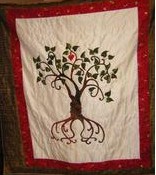

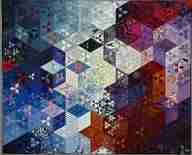
ANN FEITELSON is fascinated by 6-pointed star quilts. Her first was featured on the cover of Quilters Newsletter Magazine, in April '04. ( It's also at http://www.handsacrossthevalley.org/gallery). Her second was published in the Museum of the American Quilter's Society book, 'New Quilts from an Old Favorite: Seven Sisters.'
On the left is what she calls "Winter Quilt." On the right is a banner she made for Sukkoth.
Ann uses a combination of traditional and speed methods. An article outlining her system appeared in the November, 2005 issue of QNM, and there's more about how she does it, and her favorite tools, on my 6-Pointed Stars page.
Ann's approach does involve Y seams. When I whined to her about my own fear of Y seams, she responded like a true quilter would: "I think it's worth fussing to rotate the pieces because the geometry of it is so beautiful...It's cool when it all comes together. I'm in a rhythm with them. I can make a star in maybe only 20 minutes, that includes getting up three times to press! Then again, I flounder around about the composition, and change my mind, and change it again...but all that gives me more leftovers to work with, which is good!"
Her two recent quilts above prove that y seams, floundering, care, and sheer talent pay off! Ann teaches her method for 6-pointed stars at local fabric shops in Western Massachusetts, and can be reached at phweis(at)valinet.com.
PS: If you're a knitter, Ann's name may sound familiar. She's also the author of the book "The Art of Fair Isle Knitting" (Interweave Press, 1996).
On the left is what she calls "Winter Quilt." On the right is a banner she made for Sukkoth.
Ann uses a combination of traditional and speed methods. An article outlining her system appeared in the November, 2005 issue of QNM, and there's more about how she does it, and her favorite tools, on my 6-Pointed Stars page.
Ann's approach does involve Y seams. When I whined to her about my own fear of Y seams, she responded like a true quilter would: "I think it's worth fussing to rotate the pieces because the geometry of it is so beautiful...It's cool when it all comes together. I'm in a rhythm with them. I can make a star in maybe only 20 minutes, that includes getting up three times to press! Then again, I flounder around about the composition, and change my mind, and change it again...but all that gives me more leftovers to work with, which is good!"
Her two recent quilts above prove that y seams, floundering, care, and sheer talent pay off! Ann teaches her method for 6-pointed stars at local fabric shops in Western Massachusetts, and can be reached at phweis(at)valinet.com.
PS: If you're a knitter, Ann's name may sound familiar. She's also the author of the book "The Art of Fair Isle Knitting" (Interweave Press, 1996).
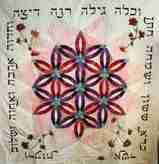

ERICA KOLATCH, from Maryland, adapted Judy Neimeyer's complex "Diamond Wedding Ring" paper-pieced pattern (available at Quiltworx.com) to create this exceptionally beautiful chuppah for her son's wedding. At the event, only the top was used---she quilted it afterwards.
The lettering---one of the seven wedding blessings---is done with fusible web and a careful, close satin stitch. "I did the first couple of letters with a white bobbin thread and a purple satin stitch thread, but even though I had the top thread fairly loose, I still had some show through. So I switched to all purple, top and bottom. When I started, I could do about 7 letters in 3 hours, but once I was comfortable with the process it got a lot faster!" Erica is at ekolatch (at) gmail.com .
The lettering---one of the seven wedding blessings---is done with fusible web and a careful, close satin stitch. "I did the first couple of letters with a white bobbin thread and a purple satin stitch thread, but even though I had the top thread fairly loose, I still had some show through. So I switched to all purple, top and bottom. When I started, I could do about 7 letters in 3 hours, but once I was comfortable with the process it got a lot faster!" Erica is at ekolatch (at) gmail.com .

DEBRA GABEL from Clarksville, Maryland, made this stunning chuppah for her nephew's wedding. The design is original, and she used both machine piecing and fused appliqué to create it. The finished size is 112" x 112". Deb is creating a pattern for this design. Her website is at www.zebrapatterns.com.
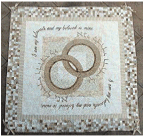

KAY BAILEY of Arlington, Virginia writes, "I started a company about a year ago to make wedding quilts and other sentimental quilted stuff. I have wanted to get into the huppa business, as I have always loved Judaica...So I have made up a couple of miniature, sample huppas, which I thought I'd pass along." Kay's mini-chuppah models are on her blog, at http://fiberofherbeing.blogspot.com/2007_03_01_archive.html. And look for the fun bat mitzvah quilt above it.

JACKIE FERRELL who lives in Long Island, NY, made this tallit "as a reflection of my belief in guardian angels in our lives," she writes. "I worked at the Orthodox Union in New York City, near the World Trade Center when it was attacked, when I was pregnant with my son. The atarah has Psalm 91:11, "for he will send his angels to watch over you wherever you go." I made a collage of pictures of the members of my family who 'passed into life eternal' as my rabbi would say, and put them on the inside of the lining where my heart is." Jan Gorelick embroidered the atarah.
Jackie also made a gorgeous appliquéd chuppah---with dolphins leaping overhead for joy!---for her sister's wedding. The pattern came from the Pacific Rim Quilt Co. And she did a smaller version as a challah cover! Contact: jackieferrell(at)verizon.net.
Jackie also made a gorgeous appliquéd chuppah---with dolphins leaping overhead for joy!---for her sister's wedding. The pattern came from the Pacific Rim Quilt Co. And she did a smaller version as a challah cover! Contact: jackieferrell(at)verizon.net.

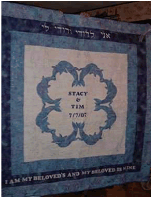

ROSALYN MANSSE, of Rancho Santa Margarita, California, made this 64" appliquéd, embroidered, and quilted chuppah for her nephew's wedding. The side borders illustrate Biblical dreams: Jacob's ladder on the left, and Joseph's dream of the sun, moon and 11 stars on the right. The house block includes a door knob made from a button that came from a skirt her grandmother bought her on a shopping trip about 50 years ago---it was Rosalyn's grandmother who taught her to sew. The apples were from one of the last drawings Rosalyn's husband was able to make for her before becoming too ill. There are also flying pink hamantaschen! The bride and groom's Hebrew names are along the bottom. Rosalyn designed all of it! Reach her at rosalynf (at) cox.net
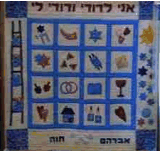
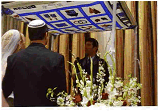

CONGREGATION AM HASKALAH, in Allentown, PA The rabbi's pregnant! What's a congregation to do? Well, first you have 39 members---young and old---make a spectacular baby quilt. Then you print up a poster of the quilt and sell it as a keepsake and/or to raise money for the shul! It's at http://www.amhaskalah.org/creativity.html. (Click on the link in the paragraph below the quilt to see a larger version).

PHYLLIS EISENBERG Some chuppot have overhangs, defining the sacred space, and giving the congregation even more to look at. But constructing chuppot with overhangs is a technical challenge. Phyllis Eisenberg did it by creating five separately quilted and bound pieces (the top, plus four sides). She joined them with a walking foot. See the results at http://www.kodakgallery.com/ShareLandingSignin.jsp?Uc=ledqc7l.b8pw5q7p&Uy=-fvcl8v&Upost_signin=Slideshow.jsp%3Fmode%3Dfromshare&Ux=0 (You don't have to sign in to see the slideshow--just click "View Slideshow.")
Phyllis adds that she's not an experienced quilter---she was 'home schooled' by a guild member. The design on the chuppah is a Stack'n'Whack. That meant only one print was used (the groom wanted only a limited number of colors). Reach her at theraphyll(at)yahoo.com.
Phyllis adds that she's not an experienced quilter---she was 'home schooled' by a guild member. The design on the chuppah is a Stack'n'Whack. That meant only one print was used (the groom wanted only a limited number of colors). Reach her at theraphyll(at)yahoo.com.

HWRM This British quilter asked that her name not be used--- her nom de plume is "Hello World Read Me," which I've abbreviated! "I'm Christian with an interest in Oriental art and philosophy. However, one of my relatives converted and married a man who's just become a rabbi - which is how I got in touch with Cathy. I'm still finding my way around all the festivals and symbolism." The piece on this page, http://www.flickr.com/photos/helloworldreadme/194979775/in/set-72157594207101986/ was inspired by the psalm line, 'I am my beloved and my beloved is mine.' Look through the other images in the set (use the arrows in the upper right)---her insect embroideries and jeweled, ruched shell forms are mind-boggling. She writes, "I've knitted (Kaffe Fassett being another inspiration), and I've studied textiles, design, painting and printmaking, while I've just taken up digital photography. Looking back, I can see that each new technique I take up enables me to make art faster - it must be something to do with getting older!"

CAROL WHITEHORN, a Newton, Mass. quilter, and the mother of the bride, made this gorgeous, folk-art style quilted chuppah. Here's how she began her speech at the reception (that's her talking in the photo, at the far left):
"Planning a wedding is an adventure. For me, the most relaxing part has been making the chuppah. The wedding is a joyous event that takes place for a few hours with many wonderful and lasting memories, but I hope this cover will last a lifetime. After each section was completed, I wanted to pick up the phone and call Lizzy [the bride] to tell her about it, since I was having so much fun!"
The quilt combines traditional American symbols--- the double wedding ring, and the heart-and-hands symbol - with many personal and whimsical touches. Georgetown University colors, blue and grey, are used because that's where the couple met. Carol asked friends to "borrow" pictures from the groom's photo albums under false pretenses, so she could include them - including one of him as a tot, wearing his Captain Lightning costume. She ordered an extra-large Northwestern University tee shirt (where the couple attended graduate school), to cut out the Wildcat mascot. She asked the grooms' father to sketch his favorite teddy bear, BooBoo, so she could appliqué him (in the upper right corner). Her daughter's childhood lovey, Humpty Dumpty, is also represented.
The chuppah was suspended from ribbons in the four corners, anchored with buttons. The poles were planted in heavy flower pots - but the day was so windy that they wound up assigning groomsmen to hang onto the poles, too, just in case.
"Planning a wedding is an adventure. For me, the most relaxing part has been making the chuppah. The wedding is a joyous event that takes place for a few hours with many wonderful and lasting memories, but I hope this cover will last a lifetime. After each section was completed, I wanted to pick up the phone and call Lizzy [the bride] to tell her about it, since I was having so much fun!"
The quilt combines traditional American symbols--- the double wedding ring, and the heart-and-hands symbol - with many personal and whimsical touches. Georgetown University colors, blue and grey, are used because that's where the couple met. Carol asked friends to "borrow" pictures from the groom's photo albums under false pretenses, so she could include them - including one of him as a tot, wearing his Captain Lightning costume. She ordered an extra-large Northwestern University tee shirt (where the couple attended graduate school), to cut out the Wildcat mascot. She asked the grooms' father to sketch his favorite teddy bear, BooBoo, so she could appliqué him (in the upper right corner). Her daughter's childhood lovey, Humpty Dumpty, is also represented.
The chuppah was suspended from ribbons in the four corners, anchored with buttons. The poles were planted in heavy flower pots - but the day was so windy that they wound up assigning groomsmen to hang onto the poles, too, just in case.
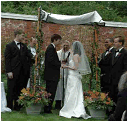
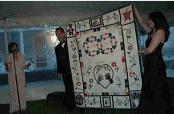

LESLIE MCCAFFERTY in New Jersey, had to do a lot of sneaking aroundto get these tallit bags ready as surprise gifts for her twin's b'nai mitzvah. Her son's elaborately pieced and hand-quilted envelope is on on the right. Her daughter's is the green velvet bag and cotton bag on the left. Yes, velvet ("I had to keep using a fray-checking liquid so the edges wouldn't fray to smithereens. I swore off velvet after that!") That tallit bag is embellished with silver beads. The fringe was made from a variegated yarn ("I cut three inch pieces, folded them in half, and sewed them to a ribbon, a la my quilting teacher Sherlene's suggestion, then inserted the piece of ribbon in to the seam").
Leslie was sorry when it was over. "Now, all those free moments I was stealing to work on the bags in secret can now be spent on other things.... Shucks, I am going to miss 'having' to quilt."
Leslie was sorry when it was over. "Now, all those free moments I was stealing to work on the bags in secret can now be spent on other things.... Shucks, I am going to miss 'having' to quilt."



